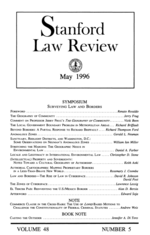“Authorial Cartographies: Mapping Proprietary Borders in a Less-Than-Brave New World”
“Authorial Cartographies: Mapping Proprietary Borders in a Less-Than-Brave New World”

“Authorial Cartographies: Mapping Proprietary Borders in a Less-Than-Brave New World.” Stanford Law Review 48(5): 1357-1366.
Abstract: They’re burning Bambi in Bangkok … and Disney executives couldn’t be happier. I want to further develop this; first to situate it historically, then to show how the author-function is at work in contemporary practices of map-making (mapping the biosphere and, it could be argued, mapping the genome.) Finally, I will return to the so-called globalization of intellectual property rights to ask some questions about the global and its relation to what I have elsewhere termed gloca-cola-nation. It is something more than a coda, however, to add that the European bourgeois public sphere was forged precisely during a period of global European expansion and colonial occupation. Moreover, a case can be made that, like so many other Enlightenment concepts, Romantic tropes, and liberal legal principles, the constitutive elements of the author/work relationship were forged and articulated on colonial terrain in encounters with cultural others. Intellectual property laws (copyright, trademark, and publicity rights, specifically) enable author/owners to expropriate meanings and values generated by the creative activities of others – to prohibit them and/or to claim them as their own. Disney used its copyright and trademark interests in the Donald Duck characters in attempts to limit the circulation of the critical texts.
Link to article
Date Published: 1996
Publisher: Stanford Law Review
Publisher Website: https://www.stanfordlawreview.org/